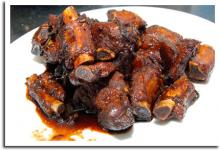 I finally made the Sweet and Sour Spare Ribs recipe that I had found in Fuchsia Dunlop’s Revolutionary Chinese Cookbook. The flavor was spot on; however, the ribs ended up a bit dry and overcooked. I found the recipe instructions to be a bit vague in terms of cooking time. In her recipe, I boiled, fried, and braised the ribs. Not sure which step caused the problems. Next time, I will omit the optional frying step and see what happens. Coincidentally, I order this same dish from a neighborhood Shanghainese restaurant, and I always think that their ribs are dry and overcooked as well. 🙂
I finally made the Sweet and Sour Spare Ribs recipe that I had found in Fuchsia Dunlop’s Revolutionary Chinese Cookbook. The flavor was spot on; however, the ribs ended up a bit dry and overcooked. I found the recipe instructions to be a bit vague in terms of cooking time. In her recipe, I boiled, fried, and braised the ribs. Not sure which step caused the problems. Next time, I will omit the optional frying step and see what happens. Coincidentally, I order this same dish from a neighborhood Shanghainese restaurant, and I always think that their ribs are dry and overcooked as well. 🙂
Tag: chinese food
-
Sweet and Sour Spare Ribs
-
Review: Revolutionary Chinese Cookbook by Fuchsia Dunlop
Amazon just sent me Fuchsia Dunlop’s Revolutionary Chinese Cookbook. This cookbook exhaustively covers Hunan cuisine. Literally. I was exhausted from reading the cookbook. The introduction? 43 pages. Four paragraphs on bean curds. Two paragraphs on garlic. It all adds up.
The first recipe is Sweet-and-Sour Spare Ribs. All recipes include the name in Chinese characters (e.g.,糖醋排骨) and in pinyin (tang cu pai gu). The author also includes an interesting historical note of the dish or how she came across the recipe. And, of course, the list of ingredients and the cooking instructions. If I have time, I will test this recipe during the coming weekend.
The largest shortfall in this cookbook is the lack of photos. While the photos of Chairman Mao memorabilia fit well with the theme of the cookbook, the home cook will be better served with a photo of the finished dish. I don’t need a full-page photo for every recipe. I have had enough sweet-and-sour spare ribs to know what that dish should look like. However, for her relatively more obscure dishes, such as Beef Slivers with “Water Bamboo,” I really need a photo. I have no idea what water bamboo (交白 or jiao bai) is. And, after reading her explanation, I still have no clue. A good photo motivates the cook to recreate the dish. I need photos in my cookbooks.
-
Time Magazine is Wrong About China
Time: Kentucky Fried Rice. Starbucks has the gall to sling its lattes for coffee connoisseurs in Vienna, and Budweiser peddles its brew in Belgium. So why shouldn’t Yum Brands–the Louisville, Ky.-based company that owns KFC, Pizza Hut, Taco Bell and more–sell dumplings in a fast-growing market where Chinese food is just called food?
In an attempt to squeeze in a lame joke, Time really missed the mark. Sure, at one time in America, going out for Chinese food meant a visit to the local Cantonese restaurant which served the same item as every other Chinese restaurant. However, this is 2008 and most major American cities offer a more diversified Chinese menu that now includes Hunan, Sichuan, Beijing, and Shanghai cuisine. So, Time should know that when Chinese people go out for lunch or dinner, they have choices as well. Chinese people don’t go out for Chinese food. They go out for Cantonese dim sum, Taiwanese food, Shanghai xiaolungbao, Northern Chinese cuisine, etc. Just like American food in America isn’t just called food. You have burgers, steaks, California cuisine, salads, Philadelphia cheese steak sandwiches, seafood, pizza, etc.